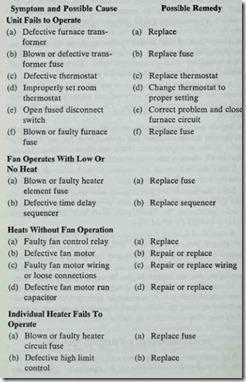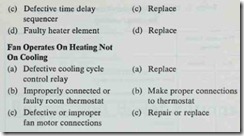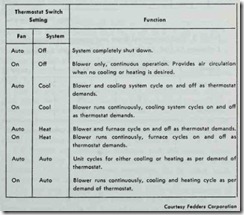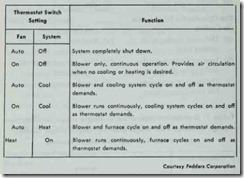BLOWERS AND MOTORS
The blowers and motors that are used with electric-fired forced warm-air furnaces are identical to those used in gas-fired furnaces.
You should read the section BLOWERS AND MOTORS in Chap ter 11 (GAS-FIRED FURNACES) for additional information.
AIR DELIVERY AND BLOWER ADJUSTMENT
It is sometimes necessary to adjust the blower speed to pro duce a temperature rise through the furnace that falls within the limits stamped on the furnace nameplate. Blower adjustment pro cedures are described in full detail in Chapter 11 (GAS-FIRED FURNACES).
AIR FILTER
The air filters used in electric-fired forced warm-air furnaces are either permanent types that can be removed and cleaned on a periodic basis, or replaceable, throw away type filters.
More detailed information concerning furnace air filters is contained in Chapter 14, Volume 3 (AIR CLEANERS AND FILTERS). Also read the sectiun on air filters in Chapter 11 ( GAS-FIRED FURNACES). The filters used in the various types of forced warm-air furnaces are essentially the same regardless of the type of fuel used to fire the unit.
AIR CONDITIONING
A furnace should be install d in parallel or on the upstream side of the cooling unit to avoii condensation in the heating sec tion. Parallel installation will require dampers or some other means to prevent cool air from entering the furnace.
The air conditioning component of a typical electric heating and cooling system generally consists of an outdoor condensing unit , indoor coils, and a cabinet to house the cooling coils. Most furnace manufacturers provide detailed instructions for adding air conditioning to the heating unit. The important thing to remember is to size the ducts for the larger volume of air used in air conditioning.
Additional information about air conditioning can be found in Chapters 7-8, Volume 3.
MAINTENANCE AND OPERATING INSTRUCTIONS
Maintenance and operating instructions will normally be pro vided for the furnace by the manufacturer. If no instructions are available, try contacting a field representative or writing the com pany for a duplicate copy of the owners manual.
Always shut off the electrical power supply to the furnace be fore attempting to service it. This is very important, because there is the possibility of a fatal electric shock. Be sure to open all furnace fused disconnect switches before servicing.
A clean air filter is important to the efficient operation of the furnace. Air filters should be removed and inspected on a periodic basis (preferably every six months). Clean or replace the filters as required.
Inspect the heating element and heating control wiring to make certain connections are tight and clean. Check for any breaks or cracks in the wire insulation. These can cause shorting. All ter minal block wiring connections should also be tight and clean.
Check the furnace wiring diagram to make certain the fuses are of the correct type and amperage.
Some fan motors are permanently lubricated and will not re quire further attention. Others have ports for oiling and require periodic lubrication. See BLOWERS AND MOTORS in Chapter 11 (GAS-FIRED FURNACES).
A combined heating and cooling system is designed to operate year around without being shut down. Only changeover that is required is that of the room thermostat and periodic maintenance.
When an electric furnace is installed without an air condition ing unit, the furnace should be shut down at the end of the heat ing season. The procedure for doing this will be found in the furnace owner’s manual. It is a simple operation which generally consists of opening the main fused disconnect switch or switches in the power supply lines serving the furnace.
TROUBLESHOOTING AN ELECTRIC FURNACE
Any appliance may sometimes fail to operate efficiently be cause of a malfunction somewhere in the equipment. The problems most commonly associated with electric-fired furnaces are listed below.
Table 1. Thermostat operation in single stage heating/two stage cooling; two stage heating/ single stage cooling; two stage heating/two stage cooling.
Table 2. Thermostat operation in single stage heating/ cooling.
Table 3. Recommended heat anticipator settings for Coleman 10 kW, 15 kW, and 20 kW electric furnaces.




